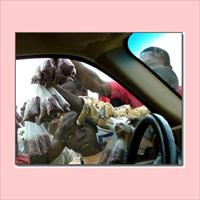KENYA: Drought forcing children to quit school

Under normal circumstances, 14-year-old Paul Katana would be in school, but not today. Katana is instead flagging down vehicles along the Mombasa-Malindi highway, hoping to sell sacks of charcoal he is hawking.
About 2km down the road, a young boy watches over his mother's goats, while another is hawking brooms.
Many children in the north-coast region are staying out of school due to a lack of food and water, after a prolonged drought.
The number of school dropouts is increasing by the day, according to education authorities. "Pupils ... can no longer concentrate on [their] studies," said Kezia Yusuf, a local teacher. Worst affected are the districts of Kaloleni, Malindi and Kilifi.
"We ... can't do much, but just call upon the government to address this [situation] before it gets out of hand," Ann Charo, a teacher in Kilifi, said.
School timetables have had to change to cope with increasing absenteeism. "We no longer have lessons in the afternoon these days because not even half the school-children return after breaking for lunch," said Leslie Katana, another teacher.
"In the afternoon, the pupils would rather stay at home and help their parents search for water and pasture for their livestock than come to school," Katana said.
The children who do make it are also reporting to class later than usual.
“There is no use having them go to school when we have no water in the house,” said Phelomena Mcharo, a mother of five, adding: "There is no way I can ask my children to attend school on an empty stomach."
School-feeding programmes crucial
According to a programme adviser with the UN World Food Programme (WFP) in Kenya, René McGuffin, some of the schools in Malindi district had been targeted for school feeding as part of an emergency programme due to the drought in 2006. The programme was for a period of two years and was phased out in term three of 2007.
However, food distribution is going on in the district of Kilifi. Kaloleni district was recently carved out of Kilifi.
McGuffin said the three districts would be included in the new school-feeding programme starting in January; the current programme ends in December.
"We did realise there are pockets of need in some of the divisions," McGuffin said. At least 60,000 school-children in the three districts are expected to benefit in the new programme.
"The government has recognised that there is a need to ensure the worst-off areas continue to receive assistance," she said. "When there is a true need based on the indicators we should be there."
Improving livelihoods
Many parents have stopped sending their children to school, said Kilifi district education officer, Dickson Ole Keisi. "They'd rather ask their children to stay at home and look after goats or do other odd jobs."
About 10 pupils from the local Jila primary school are working in a quarry in Kilifi.
Ole Keisi said the water and education ministries were working on providing adequate water to schools and the community.
NGOs were also running programmes to improve the quality of life among local communities but a great deal still needed to be done, he said. Most of the residents in the semi-arid districts live on less than US$2 a day.
Medical agency AMREF Kenya constructed water pans in Kilifi and Kaloleni, but they have since dried up due to the aridity of the land and overuse. The organisation is also helping local schools harvest rain water.
In addition, leaders are holding barazas (meetings) to sensitise parents to the importance of education. "Yes we have a [famine] problem ... but we are hopeful a lasting solution will soon be found," said Johnson Jeffer Yah, a local leader.
 Back and Next - Back and Next
Back and Next - Back and Next See Also - See Also
See Also - See Also